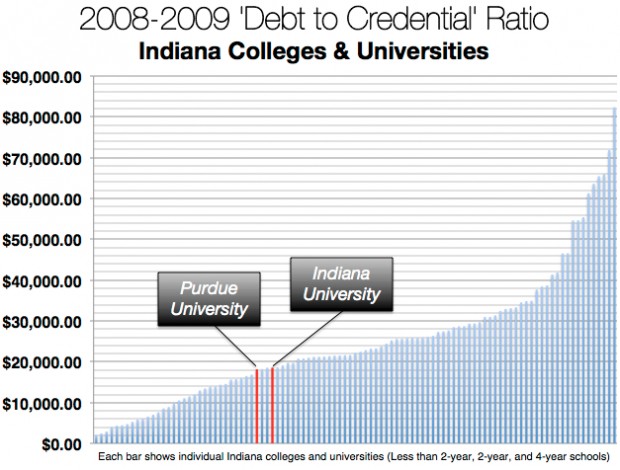Indiana Student Debt Burden Grew Sharply In Recent Years

Kyle Stokes/StateImpact Indiana
Indiana University's campus in Bloomington.
For Indiana students, getting a college degree requires taking on the kind of debt that could pay for a new car.
In 2006, that car could’ve been a Toyota. By 2009, that car could’ve been a BMW.
Undergrads at Indiana colleges or universities took on an average of $30,000 in debt for each degree they earned in 2009 — a debt load $10,200 per degree higher than the national average. The 2009 numbers were up 64 percent from the average $18,200 debt load for an undergraduate degree in 2006.
That’s according to a new dataset which claims to offer a different way to measure exactly how much debt students are taking on. But critics say the ratios it produces are misleading.
Policy analysts at Education Sector, a non-partisan education think tank, came up with a “debt to credential ratio” to draw a connection between two problems at U.S. colleges: low graduation rates and high debt burdens.
Erin Dillon, an Education Sector policy analyst who co-authored a report outlining the debt to credential ratio, told StateImpact a higher number should raise a “red flag.”
“That red flag could indicate that they have a really low graduation rate, that students are taking on lots of debt for the degrees they are earning. Most likely, it indicates both,” Dillon said.
So are there red flags waving for Indiana colleges? Take a look at the chart:

SOURCE: Education Sector, excluding outliers (College of Court Reporting, Inc. & Crossroad Bible College). Undergraduate data only.
Some takeaways from the Indiana data:
- Low ratio flagship campuses — The debt to credential ratio at Indiana University and Purdue University is relatively low compared to the rest of the state, with both IU and Purdue students shouldering an average debt load of roughly $18,000 per degree. This falls in line with the Education Sector report’s finding that the ratio tends to be lower at flagship public universities.
- High ratio regional campuses — All the regional campuses of IU and Purdue had higher average debt burdens than the Bloomington and West Lafayette campuses. Indiana University-East in Richmond had the highest ratio at $37,600, the largest average debt load per degree of any public university in the state.
Debt to Credential Ratio, Big Ten Schools, 2008-2009 School Year
| Big Ten Schools | 2008-09 |
| Northwestern | $11,230.82 |
| Wisconsin | $11,540.97 |
| Michigan | $13,349.04 |
| Minnesota | $16,601.39 |
| Illinois | $16,999.10 |
| Purdue | $18,154.09 |
| Indiana | $18,565.59 |
| Ohio State | $19,776.80 |
| Iowa | $21,475.33 |
| Michigan State | $22,798.67 |
| Nebraska | $24,180.51 |
| Penn State | $28,683.05 |
| Average | $18,612.95 |
- Four years have higher ratios — The average four-year degree in Indiana comes with a $37,500 average debt burden per degree, about $7,500 higher than the average for all of the state’s colleges and universities.
- For-profits roughly equivalent — The average debt burden at for-profit Indiana colleges ($29,900) is almost equivalent to the average debt burden at not-for-profit and public colleges in Indiana. But among four-year colleges, for-profit colleges make up six of the top ten debt to degree ratios.
Interpret With Caution
Some have criticized Education Sector’s study for failing to track individual students. The dataset compares total undergraduate debt at an institution to the number of degrees issued in one year, providing what Dillon calls a “snapshot of an institution.” But Inside Higher Education reports one analyst says the resulting ratio can be confusing:
Outside experts said the study’s premise and conclusions were interesting but flawed in some ways, in part because it doesn’t give a clear picture of individual students’ debt burdens. “Are you trying to encourage fewer students borrowing, or are you trying to encourage less borrowing by the students who do borrow?” said Art Hauptman, an independent policy analyst. Comparing a dollar figure with the number of graduates can confuse the issue, Hauptman said.
Dillon says the ratio isn’t a good indicator of a specific problem at a university, but urges critics not the miss the forest for the trees. The data, she says, indicate a sharp overall increase in student debt in recent years. As she told StateImpact:
I think it’s an important conversation that we need to have. Colleges continue to increase tuition prices and students are asked to take on more and more debt for a college degree with the promise that it will be worth it financially, but we haven’t had a conversation about exactly that question, which is, ‘How much debt should we ask students to be taking? And is it at that point where it becomes unreasonable to ask students to take on that much?’
